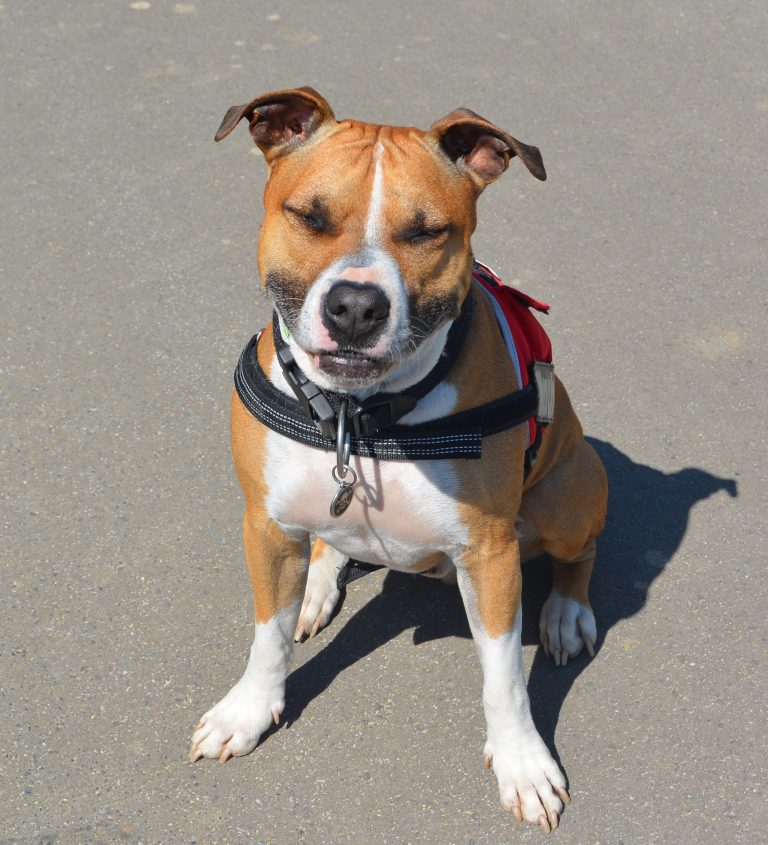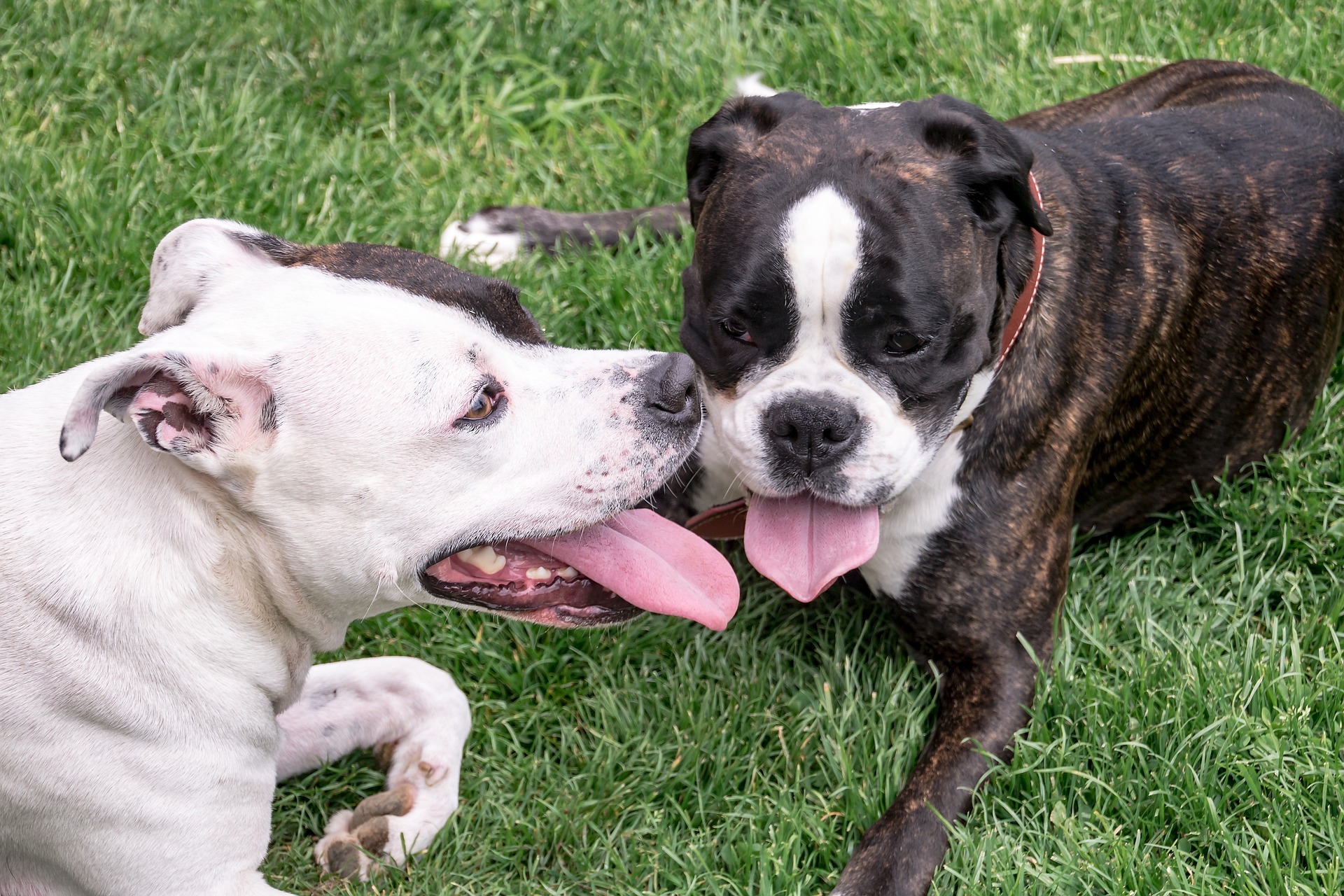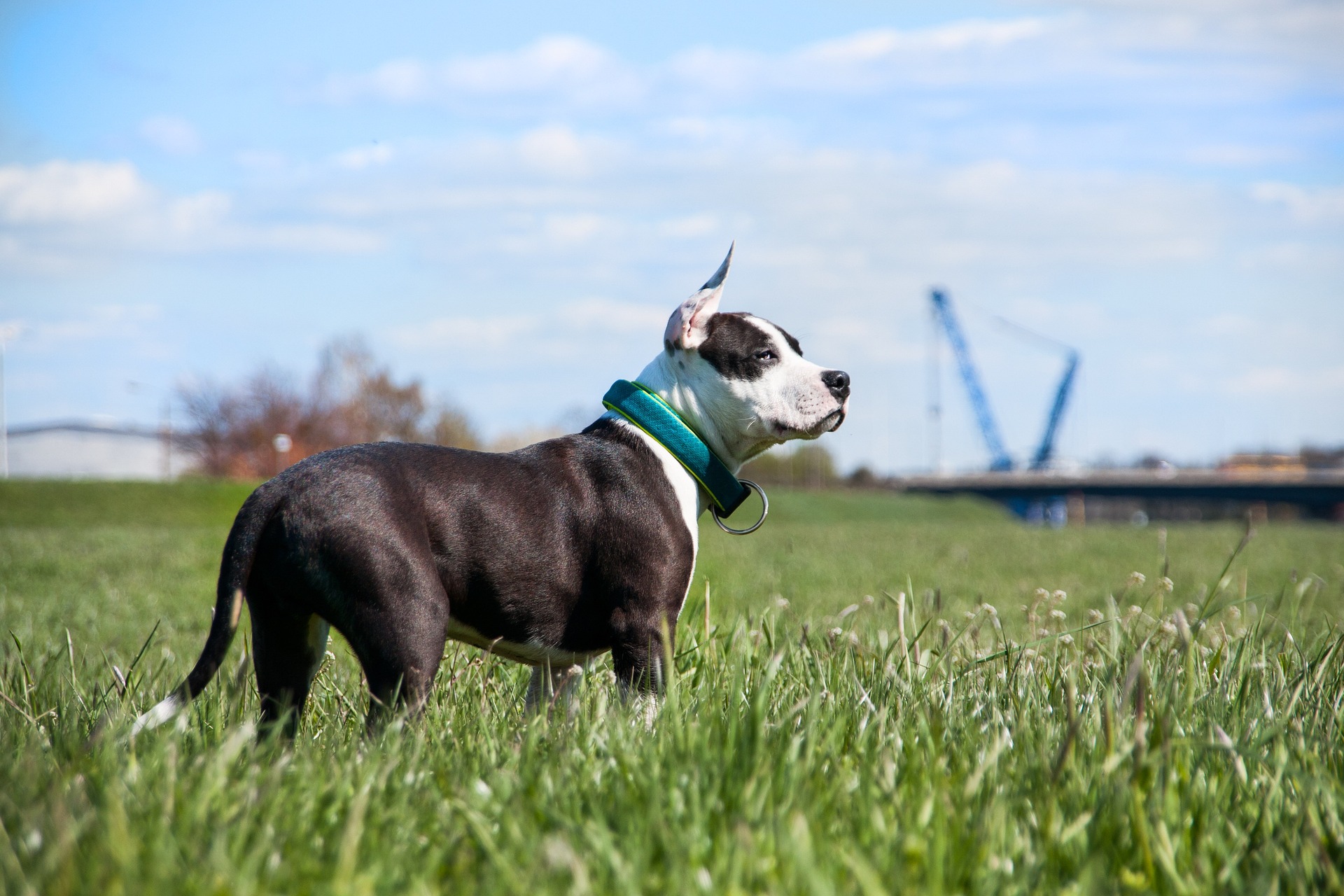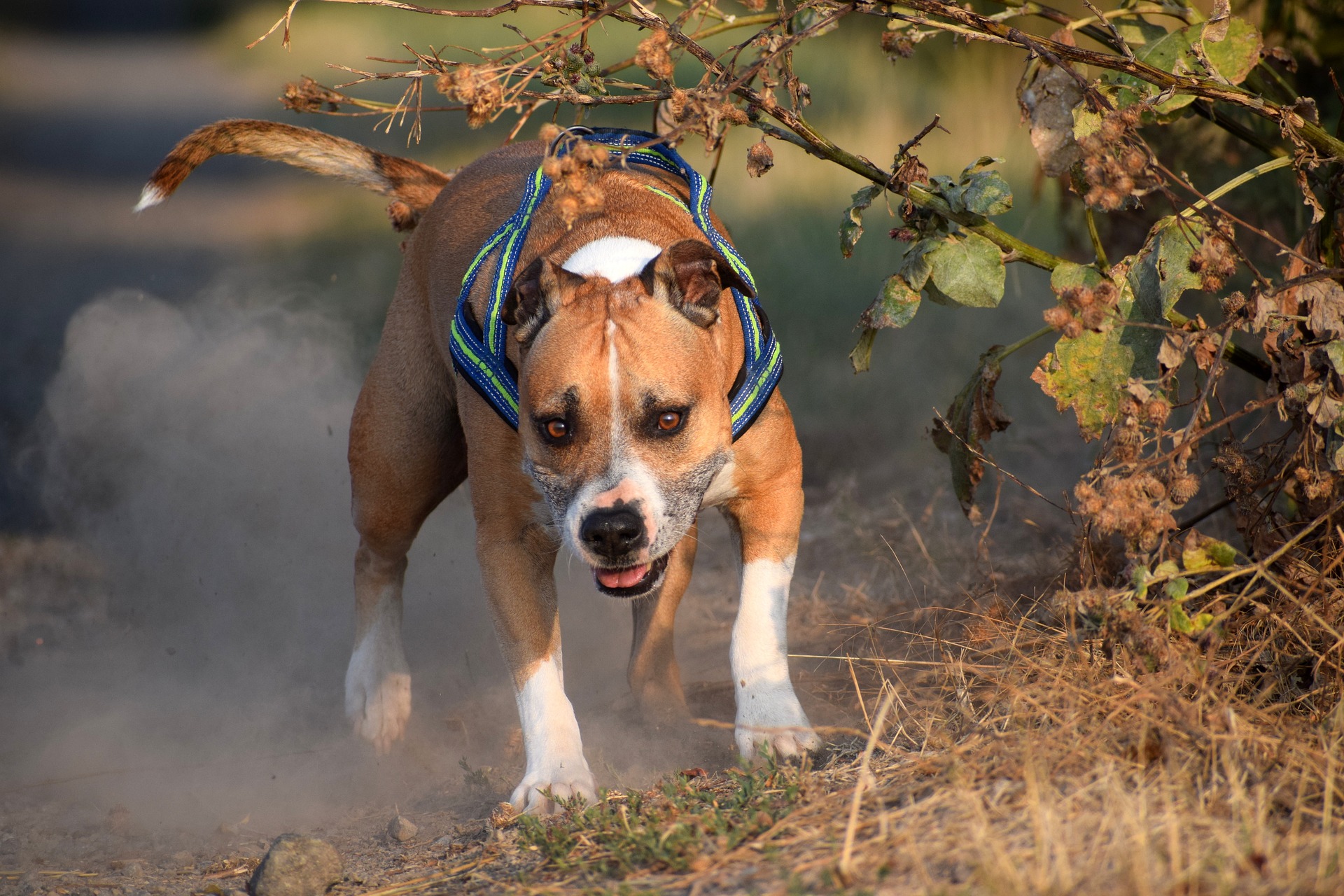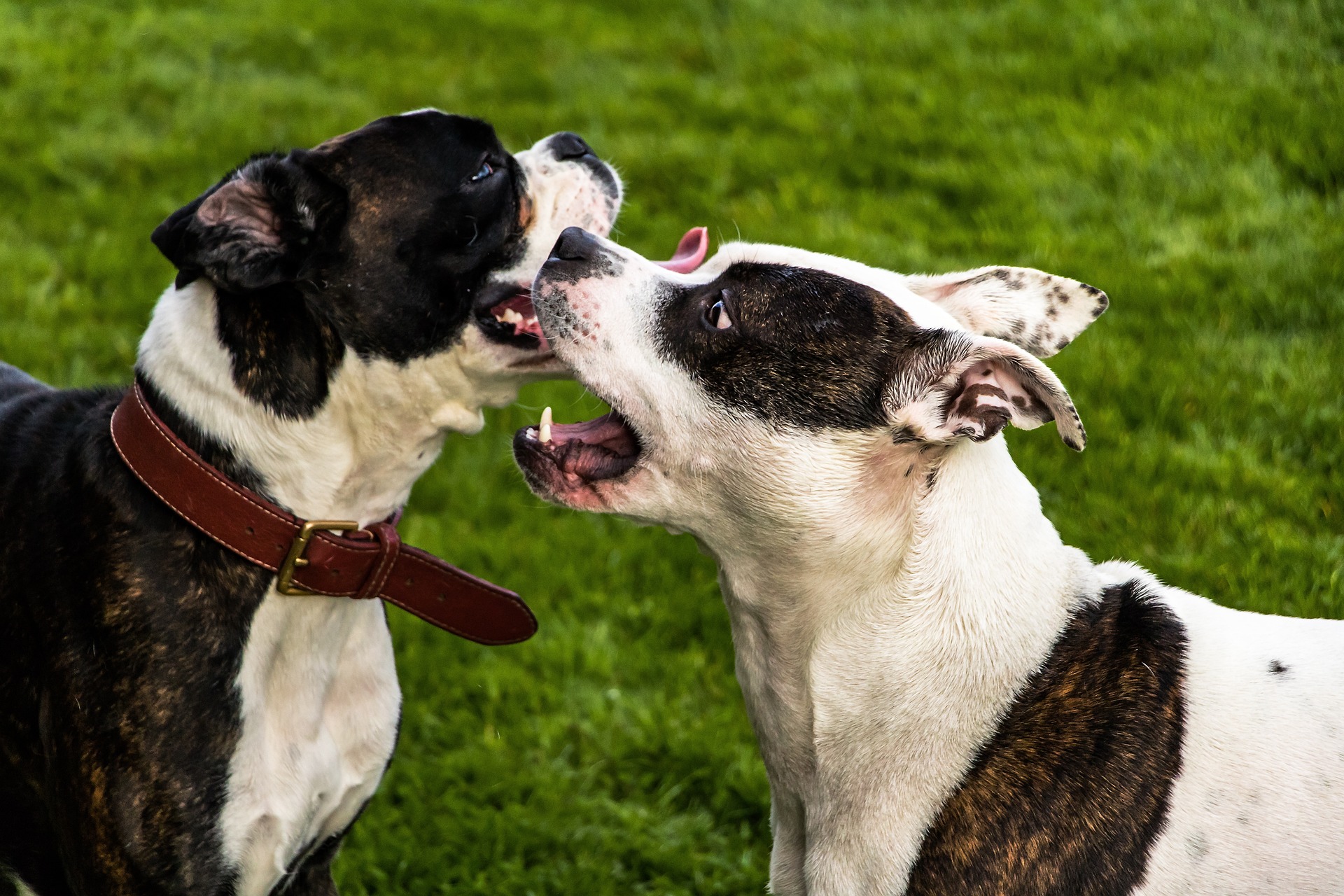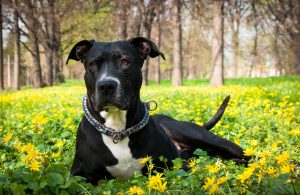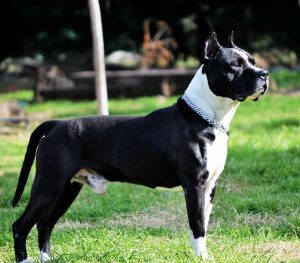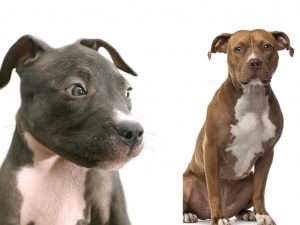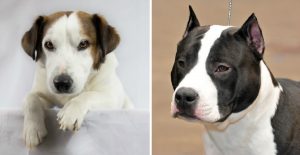The American Staffordshire Terrier, affectionately known as the Amstaff, is not only admired for its steadfast loyalty and affectionate temperament but also for its vibrant coat colors and interesting patterns that contribute to its distinctive appearance.
As a breed rich in diversity, American Staffordshire Terriers can sport a broad palette of coat colors which reflect the breed’s interesting genetic makeup.
Their coats can be a single solid block of color or a mix, including shades like black, brown, blue, fawn, red, and liver.
In addition to these hues, the Amstaff may exhibit classic patterns such as brindle and have white markings which add to their visual appeal.
These dogs are more than just their looks; their personality shines through their expressive colors. They are known for being loving companions that form strong bonds with their families.
Nowadays, a lot of people mistake the American Staffordshire Terrier for the American Pit Bull Terrier. That is because the American Kennel Club recognizes all pitbull-type breeds under the term American Staffy. But the reality is that the Amstaff is a different dog breed. It falls under the Pitbull umbrella term, along with the American Pit Bull Terrier, American Bully, and American Bulldog.
The Amstaff brings a lot of love and joy to a home and their colors often seem to mirror their playful and spirited nature.
Owners can enjoy not just the loyalty and friendship of an American Staffy but also the unique aesthetic that their array of coat colors adds to their daily lives.
Key Takeaways
- Amstaffs showcase a wide range of coat colors and patterns
- Their coat colors reflect a rich genetic diversity
- Amstaffs are affectionate companions whose appearance mirrors their lovable temperament
Breed History and Origins
Before diving into the vivid tapestry that makes up the American Staffordshire Terrier’s color palette, it’s essential to understand where this robust and spirited breed comes from.
American Staffordshire Terrier vs. Staffordshire Bull Terrier
The American Staffordshire Terrier, often affectionately called the AmStaff, shares a common lineage with the Staffordshire Bull Terrier. However, once breeders in the United States got hold of these dogs, they began to emphasize a larger frame and different temperament traits.
The American Kennel Club (AKC) recognizes the AmStaff as a separate dog breed. The AmStaff was bred for companionship and performance, as opposed to the smaller, UK-based Staffordshire Bull Terrier that is recognized by both the AKC and the United Kennel Club (UKC). American Pitbull Terrier and American Bully are not recognized by the AKC as separate breeds.
Ancestors and the Bull and Terrier Breeds
Their story began in England, where their ancestors, the bull and terrier breeds, were forged in the crucible of blood sports such as bull-baiting and illegal dog fighting in the 1800s.
When these barbaric practices were outlawed, responsible breeders sought to redirect these courageous dogs towards a more sociable existence.
They combined the fervor of the terrier with the strength of the bulldog to cater to new roles beyond the fighting pits, giving birth to the Staffordshire Terrier.
As these dogs made their way to America, they evolved into what we know today as the American Staffordshire Terrier, recognized with distinction for its unique traits and qualities by the American Kennel Club in 1936.
Characteristic Colors and Coat Patterns
The American Staffordshire Terrier breed enchants with a spectrum of coat colors and patterns, making each one distinct.
These colors aren’t just about looks; they’re woven into the breed’s identity. Here’s what enthusiasts and future owners should know.
Recognized Coat Colors
The American Staffordshire Terrier dog breed’s coat colors range widely, with eighteen possible hues recognized, each bringing its unique flair.
Among these, some standard colors include:
- Red: A deep, rich color that’s eye-catching and fairly common among the breed.
- Black: A standard color which offers a sleek and powerful appearance
- Blue: Not to be mistaken for black, this shade is a dark tone of blue and highly sought after
- Fawn: A light brownish-yellow which comes in varying tones from pale to more intense shades
- White: Often seen in combination with other colors, but can also be a dominant solid color
Solid colors are prevalent, but the American Kennel Club (AKC) often prefers Amstaffs that have no less than 80% of any single color.
Brindle and its Variations
Brindle is a pattern rather than a specific color, characterized by tiger-stripe or marbling effects that overlay the base color.
The Amstaff showcases a variety of brindle types:
- Black Brindle: The classic stripes are layered over a black base coat
- Blue Brindle: Features a beautiful merging of blue tones with the brindle pattern
- Red Brindle: A striking combination of red hues mingled with darker stripes
- Fawn Brindle: Lighter background of fawn with darker stripes overlying it
This coat pattern is adored for its complexity and is often preferred in the ring for its distinctive beauty.
Blue Coats and Blue Nose Pitbulls
A subsection dedicated to blue-coated American Staffordshire Terriers is essential, as there is often confusion between these and the colloquially named “Blue Nose Pitbulls.” The specific coat qualities include:
- Blue American Staffordshire Terrier: Exhibits a pure blue coat that can sometimes appear so dark it’s almost black. However, the distinction lies in the blue tinge seen when in proper light
- Blue Nose: This term is often used incorrectly to describe a Blue Amstaff, but it actually refers to the blue coloring of the nose leather, not the coat itself. It’s important to note that a blue coat doesn’t necessarily guarantee a blue nose
These tones can also appear in combinations, creating patterns such as blue fawn or blue brindle, enhancing the breed’s diversity. Regardless of the hue, each blue American Staffordshire Terrier carries its color with undeniable grace.
Physical Traits and Markings
When you first meet an American Staffordshire Terrier breed, you’ll likely be struck by their robust physique and the unique colors and patterns that grace their coat.
They’re a muscular and sturdy medium-sized breed known for their distinctive physical characteristics. Let’s look more closely at these Traits.
Size and Build
American Staffordshire Terriers have a strong, muscular build that reflects their agility and strength. Typically:
- Females stand about 17 to 18 inches tall at the shoulder
- Males are slightly taller, ranging around 18 to 19 inches
Their size and build are a testament to the breed’s history as a hard-working dog.
Facial Features and Ears
Their head is broad with pronounced cheekbones, and they sport well-defined jaws.
The ears can be left natural or cropped, based on owner preference.
Ears are short, which contributes to their alert and keen expression, while dark, round eyes set the stage for their engaging and confident gaze.
Tail, Hindlegs, and Toes
The tail of an AmStaff is of medium length and tapers to a point. It is not docked as with some breeds.
Their hindlegs are powerful and provide strong propulsion, while the toes are well arched, packing the punch needed for powerful movement.
Unique Color Markings
The coat of an American Staffordshire Terrier comes in a variety of colors, from solid hues to mixes with unique color markings and white spots.
Some may have large black patches over a white background. In other instances, small patches are present, which can be particularly charming and are often a mark of a purebred dog.
Their coat is short, stiff to the touch, and glossy, requiring minimal grooming.
Genetic Factors Influencing Amstaff Colors
The coat colors of the American Staffordshire Terrier are a vibrant display of genetics at play. A dance of dominant and recessive genes, as well as the pigment types eumelanin and phaeomelanin, give each Amstaff that special hue they wear.
Dominant and Recessive Genes
It’s a game of genetic cards, and dominant genes hold the aces.
When it comes to Amstaff colors, these dominant players can overshadow their recessive counterparts.
The genes lay out the rules: Two dominant genes together or a dominant and recessive gene pair will default to the dominant trait, shaping the dog’s coat color.
But don’t count out the recessive genes just yet; they may hide in the background when a dominant gene is present, but when two recessives pair up, they get their moment in the spotlight.
Take chocolate or seal brown, for example – these are often recessive shades. In order to express these colors, puppies need to inherit the gene from both parents.
So, a surprise of chocolate might just pop up in a litter where the parents carried the recessive gene, subtly, without showing it themselves.
Eumelanin and Phaeomelanin
Pigment takes center stage in the color show, and there are two main types to thank for the variety: eumelanin and phaeomelanin.
Eumelanin is like the versatile actor of pigments, usually appearing black but capable of transforming into chocolate or grey when modified by other genetic factors.
It’s responsible for darker tones like fawn sable, and when diluted, it can create that blueish or grey quality in blue American Staffordshire Terriers.
On the other hand, phaeomelanin brings the warmth, contributing to the reds and golds of the Amstaff palette, including shades like red sable.
The intensity of these colors can vary from a deep, rich red to a lighter fawn sable, depending on the genes at play. These pigment proteins truly are the artists painting the diverse spectrum of Amstaff coat colors.
Caring for Your American Staffordshire Terrier’s Coat
American Staffordshire Terriers boast a variety of coat colors that are both beautiful and low maintenance. Their coat care is straightforward, but it’s essential to keep them clean and comfortable.
Grooming Requirements
American Staffordshire Terriers are blessed with a short, stiff coat that is relatively easy to care for.
Regular grooming is key to maintaining a healthy coat and minimizing shedding.
Here’s a quick guide to keep their coat looking its best:
- Brushing: Weekly brushing with a firm bristle brush helps remove dirt and loose hair
- Bathing: Bathing every month or as needed keeps their coat clean without over-drying the skin
- Nail Trimming: Keep nails trimmed regularly to avoid discomfort and mobility issues
- Ear Cleaning: Clean their ears as needed to prevent wax buildup and infections
If American Staffordshire Terriers are well-socialized, they’ll find grooming a pleasurable activity, building trust with their owner.
Handling Skin Allergies
Skin allergies are not uncommon in American Staffordshire Terriers, sometimes manifesting through their coat.
If a dog has been responsibly bred, the risk of allergies can be minimized. Still, owners should be vigilant and respond to any signs of discomfort.
Here are a few tips:
- Regular Checkups: Monitor their skin for any signs of irritation or unusual shedding
- High-quality Diet: A well-balanced diet can promote a healthy coat and skin
- Immediate Attention: Should symptoms of allergies appear, consult a veterinarian promptly
- Hygiene: Keep their sleeping area clean to reduce exposure to allergens
Staying attentive and addressing any signs of skin allergies early ensures your AmStaff remains happy and healthy.

